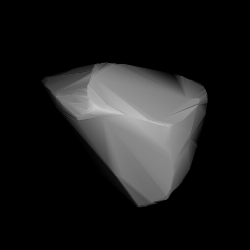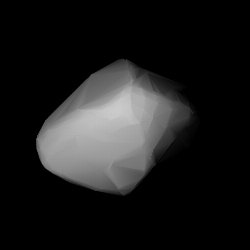Related Research Articles
4349 Tibúrcio, provisional designation 1989 LX, is a dark asteroid from the central region of the asteroid belt, approximately 29 kilometers in diameter. It was discovered on 5 June 1989, by German astronomer Werner Landgraf at ESO's La Silla Observatory in northern Chile.
6433 Enya, provisional designation 1978 WC, is a stony background asteroid from the inner regions of the asteroid belt, approximately 7 kilometers in diameter. It was discovered on 18 November 1978, by Czech astronomer Antonín Mrkos at the Kleť Observatory in the Czech Republic. It was named for Irish musician Enya.
1151 Ithaka, provisional designation 1929 RK, is a carbonaceous asteroid from the inner regions of the asteroid belt, approximately 14 kilometers in diameter. It was discovered by Karl Reinmuth at the Heidelberg-Königstuhl State Observatory in 1929, and later named for the Greek island of Ithaca.
1159 Granada, provisional designation 1929 RD, is a dark background asteroid and relatively slow rotator from the inner regions of the asteroid belt, approximately 30 kilometers in diameter. It was discovered on 2 September 1929, by astronomer Karl Reinmuth at the Heidelberg Observatory in southwest Germany. The asteroid was named for the Spanish city and province of Granada.
(9928) 1981 WE9, provisional designation 1981 WE9, is a stony Florian asteroid from the inner regions of the asteroid belt, approximately 3 kilometers in diameter. It was discovered on 16 November 1981, by astronomers at Perth Observatory in Bickley, Australia.
11277 Ballard, provisional designation 1988 TW2, is a Phocaea asteroid from the inner regions of the asteroid belt, approximately 6.3 kilometers (3.9 miles) in diameter. It was discovered on 8 October 1988, by American astronomer couple Carolyn and Eugene Shoemaker at the Palomar Observatory in California. The assumed S-type asteroid has a rotation period of at least 10 hours. It was named for American marine scientist Robert Ballard.
3996 Fugaku, provisional designation 1988 XG1, is a stony Florian asteroid from the inner regions of the asteroid belt, approximately 5.5 kilometers in diameter. It was discovered on 5 December 1988, by Japanese amateur astronomers Masaru Arai and Hiroshi Mori at Yorii Observatory in central Japan. It was named for Mount Fuji, Japan.
2571 Geisei, provisional designation 1981 UC, is a stony Florian asteroid from the inner regions of the asteroid belt, approximately 6 kilometers in diameter. It was discovered by Japanese astronomer Tsutomu Seki at Geisei Observatory on 23 October 1981, and named for the Japanese village of Geisei.
2126 Gerasimovich, provisional designation 1970 QZ, is a stony background asteroid from the inner regions of the asteroid belt, approximately 8 kilometers in diameter. It was discovered on 30 August 1970, by Soviet astronomer Tamara Smirnova at the Crimean Astrophysical Observatory in Nauchnyj, on the Crimean peninsula. The asteroid was named after Russian astronomer Boris Gerasimovich.
2324 Janice, provisional designation 1978 VS4, is a dark background asteroid from the outer regions of the asteroid belt, approximately 25 kilometers (16 miles) in diameter. It was discovered on 7 November 1978, by American astronomers Eleanor Helin and Schelte Bus at the Palomar Observatory in California. The asteroid was named for Janice Cline at Caltech. The presumably C-type asteroid has a rotation period of 23.2 hours.
5385 Kamenka, provisional designation 1975 TS3, is a background asteroid from the outer regions of the asteroid belt, approximately 16 kilometers (10 miles) in diameter. It was discovered on 3 October 1975, by Soviet astronomer Lyudmila Chernykh at the Crimean Astrophysical Observatory in Nauchnij, on the Crimean peninsula. The presumed C-type asteroid has a rotation period of 6.68 hours. It was named for the Ukrainian town of Kamianka.
4944 Kozlovskij, provisional designation 1987 RP3, is a carbonaceous Witt asteroid from the central regions of the asteroid belt, approximately 10 kilometers (6 miles) in diameter. It was discovered on 2 September 1987, by Soviet astronomer Lyudmila Chernykh at the Crimean Astrophysical Observatory in Nauchnij, on the Crimean Peninsula. The asteroid was named for Russian opera singer Ivan Kozlovsky.
4147 Lennon, provisional designation 1983 AY, is a stony Vestian asteroid and a potentially slow rotator from the inner regions of the asteroid belt, approximately 7 kilometers in diameter. It was discovered by American astronomer Brian Skiff at Lowell's Anderson Mesa Station on 12 January 1983. It was later named after musician John Lennon.
1383 Limburgia, provisional designation 1934 RV, is a carbonaceous asteroid from the outer region of the asteroid belt, approximately 23 kilometers in diameter. It was discovered on 9 September 1934, by Dutch astronomer Hendrik van Gent at the Leiden Southern Station, annex to the Johannesburg Observatory in South Africa. It is named for the Dutch province Limburg.

1582 Martir, provisional designation 1950 LY, is a carbonaceous background asteroid from the outer regions of the asteroid belt, approximately 37 kilometers in diameter. It was discovered on 15 June 1950, by Argentine astronomer Miguel Itzigsohn at the La Plata Astronomical Observatory in Argentina. The asteroid was named after the First Lady of Argentina, Eva Perón.
1405 Sibelius, provisional designation 1936 RE, is a stony Florian asteroid from the inner regions of the asteroid belt, approximately 8 kilometers in diameter. It was discovered on 12 September 1936, by Finnish astronomer Yrjö Väisälä at Turku Observatory in Southwest Finland. The asteroid was named after composer Jean Sibelius.
3823 Yorii, provisional designation 1988 EC1, is a carbonaceous asteroid from the outer region of the asteroid belt, approximately 11 kilometers in diameter.
4760 Jia-xiang, provisional designation 1981 GN1, is a background asteroid from the inner regions of the asteroid belt, approximately 5 kilometers (3 miles) in diameter. It was discovered on 1 April 1981, by astronomers at Harvard University's Oak Ridge Observatory in Massachusetts, United States. The presumed stony S-type asteroid was named after Chinese astronomer Zhang Jiaxiang. It has a rotation period of 14.96 hours.

1422 Strömgrenia, provisional designation 1936 QF, is a stony Florian asteroid from the inner regions of the asteroid belt, approximately 5.5 kilometers in diameter. It was discovered on 23 August 1936, by German astronomer Karl Reinmuth at Heidelberg Observatory in southern Germany, and named after Swedish-Danish astronomer Svante Elis Strömgren.
57868 Pupin, provisional designation 2001 YD, is a dark Erigonian asteroid and slow rotator from the inner regions of the asteroid belt, approximately 3.5 kilometers in diameter. It was discovered on December 17, 2001, by astronomers of Near-Earth Asteroid Tracking (NEAT) at the Palomar Observatory in California, United States. The asteroid was named after Serbian–American physicist Mihajlo Pupin.
References
- 1 2 3 4 "JPL Small-Body Database Browser: 11441 Anadiego (1975 YD)" (2017-03-30 last obs.). Jet Propulsion Laboratory . Retrieved 23 June 2017.
- 1 2 3 4 5 "11441 Anadiego (1975 YD)". Minor Planet Center. Retrieved 7 September 2016.
- 1 2 3 4 Mainzer, A.; Grav, T.; Masiero, J.; Hand, E.; Bauer, J.; Tholen, D.; et al. (November 2011). "NEOWISE Studies of Spectrophotometrically Classified Asteroids: Preliminary Results". The Astrophysical Journal. 741 (2): 25. arXiv: 1109.6407 . Bibcode:2011ApJ...741...90M. doi:10.1088/0004-637X/741/2/90.
- 1 2 Masiero, Joseph R.; Mainzer, A. K.; Grav, T.; Bauer, J. M.; Cutri, R. M.; Dailey, J.; et al. (November 2011). "Main Belt Asteroids with WISE/NEOWISE. I. Preliminary Albedos and Diameters". The Astrophysical Journal. 741 (2): 20. arXiv: 1109.4096 . Bibcode:2011ApJ...741...68M. doi:10.1088/0004-637X/741/2/68.
- 1 2 3 4 Masiero, Joseph R.; Mainzer, A. K.; Grav, T.; Bauer, J. M.; Cutri, R. M.; Nugent, C.; et al. (November 2012). "Preliminary Analysis of WISE/NEOWISE 3-Band Cryogenic and Post-cryogenic Observations of Main Belt Asteroids". The Astrophysical Journal Letters. 759 (1): 5. arXiv: 1209.5794 . Bibcode:2012ApJ...759L...8M. doi:10.1088/2041-8205/759/1/L8.
- 1 2 3 4 5 "LCDB Data for (11441) Anadiego". Asteroid Lightcurve Database (LCDB). Retrieved 7 September 2016.
- 1 2 Hills, Kevin (January 2014). "Asteroid Lightcurve Analysis at Riverland Dingo Observatory (RDO): 2013 Results". The Minor Planet Bulletin. 41 (1): 2–3. Bibcode:2014MPBu...41....2H. ISSN 1052-8091.
- 1 2 3 Veres, Peter; Jedicke, Robert; Fitzsimmons, Alan; Denneau, Larry; Granvik, Mikael; Bolin, Bryce; et al. (November 2015). "Absolute magnitudes and slope parameters for 250,000 asteroids observed by Pan-STARRS PS1 - Preliminary results". Icarus. 261: 34–47. arXiv: 1506.00762 . Bibcode:2015Icar..261...34V. doi:10.1016/j.icarus.2015.08.007.
- ↑ "MPC/MPO/MPS Archive". Minor Planet Center. Retrieved 7 September 2016.